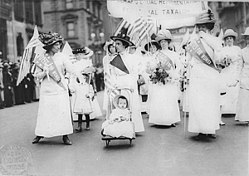Women's suffrage

The movement for women's suffrage, led by suffragists (peaceful protestors) and suffragettes (violent protestors), was a social, economic and political reform movement aimed at extending the suffrage (the right to vote) to women, advocating equal suffrage (abolition of graded votes) rather than universal suffrage (abolition of all discrimination, for example due to race), which was considered too radical.
In 1869 the Wyoming Territory in the United States became the first modern polity where equal suffrage was extended to women. That same year, the legislature in the Utah Territory passed an act giving women in Utah the right to vote. This right was later revoked by the US congress in the Edmunds-Tucker Act in 1887. The small British colony of the Pitcairn Islands, (2005 population: 46) extended suffrage to women in 1838. In 1893, New Zealand was the first country to introduce universal suffrage, following a movement led by Kate Sheppard. Women first achieved the right to stand for public office in South Australia in 1894, along with suffrage in that state.
Timeline
Women's suffrage has been granted (and been revoked) at various times in various countries throughout the world. In many countries women's suffrage was granted before universal suffrage, so women (and men) from certain races were still unable to vote.
The first women's suffrage (with the same property qualifications as for men) was accidentally granted in New Jersey in 1776 (the word "people" was used instead of "men") and rescinded in 1807. The Pitcairn Islands granted women's suffrage in 1838. Various countries and states granted restricted women's suffrage in the latter half of the nineteenth century, starting with South Australia in 1861.
The first unrestricted women's suffrage in terms of voting rights (women were not initially permitted to stand for election) in a major country was granted in New Zealand. The women's suffrage bill was adopted mere weeks before the general election of 1893.
The first to grant universal suffrage and allow women to stand for parliament was South Australia, in 1894. In Finland, women were granted the right both to vote (universal and equal suffrage) and to stand for election in 1906.
In the years before the First World War, Norway and Denmark also gave women the vote, and it was extended throughout Australia. A further wave of reform began after the war, giving most British and all German women the vote in 1918 and American women the vote in 1920. Most major powers extended the franchise prior to WWII with the exception of France and Japan, which did not allow women to vote until 1945.
The first Arab women with the right to vote were in Israel in 1948 when the country was founded.
The last Western states to extend suffrage were Switzerland in 1971 and Liechtenstein in 1984. Since then only a handful of states have not extended the franchise to women, usually on the basis of certain interpretations of the Koran. Bhutan allows one vote per property, a policy many claim in practice prevents women from voting.
Countries without women's suffrage
Some countries do not extend suffrage to women, or extend it differently from that extended to men (this list does not include countries where neither men nor women have suffrage):
- Bhutan -- Partial suffrage. One vote per house, which in practice prevents many women from voting.
- Brunei -- No suffrage for women.
- Lebanon -- Partial suffrage. Proof of education required for women, not required for men. Voting compulsory for men, optional for women.
- Saudi Arabia -- No suffrage for women.
- Kuwait -- No suffrage for women yet. The vote is to be extended to women by 2007. [1].
United States
Reference
- "Woman suffrage" in Collier's New Encyclopedia, X (New York: P.F. Collier & Son Company, 1921), pp. 403-405.
See also
- List of suffragists and suffragettes
- List of democracy and elections-related topics
- suffragette
- League of Women Voters
- National Woman's Suffrage Association
- Seneca Falls Convention, Seneca Falls Declaration of Sentiments
- The New Northwest
- Women in the Victorian Era
- Women's political rights in Bahrain
- Women's suffrage in South Carolina
- Equal Rights Amendment (ERA)
- Reproductive rights - issues regarding "reproductive freedom"
- Convention on the Elimination of All Forms of Discrimination Against Women (CEDAW)
- International Women's Rights Action Watch (IWRAW)
- Vindication of the Rights of Women
- Women's right to know
- Committee on Women's Rights and Gender Equality
- Subjection of women
- League of Women Voters
- In Defense of Women
- Parental leave
